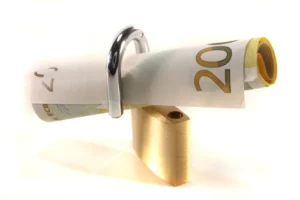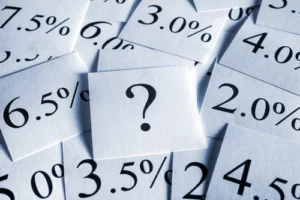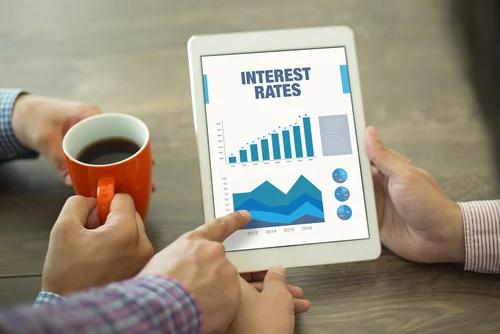- Posted on
- Kortney Murray
- 0
Are you looking to get a small business loan, but are bogged down by all the confusing financial jargon? Interest rates are extremely important when it comes to your loan costs, and you will need to know the options available before you proceed. In this article, we will discuss the two kinds of interest rates, and explain the difference between fixed vs variable rates.
What are Interest Rates?
An interest rate is a rate charged by a lender for money that is being borrowed. This represents the yearly cost of the loan. It is usually expressed as a per annum percentage or Annual Percentage Rate (APR). APR rates include both the interest rate plus other fees connected to your loan, encompassing all costs in one rate.
Keep in mind that interest rates are based on many things, including your credit score. Fortunately, there are ways to get a loan with a reasonable interest rate even if you have bad credit! There are two basic types of interest rates: Fixed and variable. But which one is right for you and your business? It all goes on a case-by-case basis, so let’s explore them one by one.

What is a Fixed Interest Rate?
A fixed interest rate is an interest rate that will stay the same during the life of the loan. So the cost of borrowing the money will stay the same, even if the market goes up or down. Fixed-rate mortgages are the most popular type of mortgage due to their predictability and stability.
With a fixed rate, the borrower will pay standard monthly payments for mortgages, car loans, or personal loans. That being said, sometimes fixed interest rates may only apply to part of a loan term. These are hybrid interest rate options, which means you may have a fixed rate for part of the loan term, and then an adjustable rate will be applied to the balance.
We will discuss this hybrid later in this article. Typically going for a fixed interest rate is a good idea when overnight rates are rising. This kind of loan is great for business owners who are looking to expand with an acquisition or make any major capital investment.
That’s because the expansion or investment can lead to continued revenue growth while the monthly payments keep steady. As revenue streams in, the payments become much easier to pay as time goes on.
Pros:
- The rate offers predictability, which means no surprise increase in payments
- Avoids the risk of floating or variable interest rate
- Makes it easy to budget for your future since you know the long-term costs of borrowing
- An attractive option when lower interest rates are available
Cons:
- Rates may be higher than adjustable rates depending on the market
- If rates decrease, you may pay more for your loan than adjustable loans because you are locked in
- When refinancing to get a lower rate, it will probably be expensive (closing costs, etc.) and probably will take up a lot of time
Calculating fixed interest rate costs
Figuring out how much a fixed-rate loan will cost you is pretty simple. Next, we will walk you through how to calculate fixed interest rate costs. You will need:
- The loan amount: How much money are you asking for? This is also called the principal.
- The interest rate: What fixed interest rate has your lender quoted you? Keep in mind that the interest rate refers to how much percentage of the principal will cost you annually.
- The loan repayment period: This is the time frame that your lender expects you will be able to pay off the loan.
Use an online payment calculator to figure out your monthly payments. Plug in your loan amount, interest rate, and the loan repayment period to get your answer.
For example, let’s say Bob wants to buy a house. He took out a $200,000 principal loan amount at 3.5% fixed interest for a repayment period of 30 years and will have a monthly payment of $898.09. The total cost of the loan would be $323,312.18 and the total interest paid would be $123,312.18.
Was the fixed interest rate a good choice in his case? We will find out when we compare his hypothetical situation with a variable interest rate loan.

What is a Variable Interest Rate?
A variable interest rate, sometimes called an adjustable or floating rate, is a rate that goes up and down over time. The rate is based on an underlying benchmark interest rate or index that changes. This means your monthly loan payment could change with market rate changes.
Variable-rate loans have some advantages for small businesses. This is because they typically offer lower rates initially compared to fixed rates. Also, lenders are usually willing to lend more if you go with a variable rate because it is less risk they will have to assume.
Variable interest rates are often used for things like credit cards, private student loans, and home equity lines of credit (HELOCs). With variable-rate student loans and credit cards, the interest rate and monthly payment could change right after the loan is disbursed. In turbulent markets, you might see the rate adjusted monthly!
If you are interested in a business line of credit instead of a term loan, it will more than likely be at a variable rate. This allows for more flexibility when it comes to repayment.
Adjustable-Rate Mortgages (ARMs)
Let’s talk about the hybrid rate we mentioned earlier. With mortgages, homebuyers are able to lock in an initial fixed rate that will last a certain amount of time. This type of loan is called an adjustable-rate mortgage (ARM). There are different kinds of ARMs including:
- 3/1 ARMs: Features fixed rates for the first three years
- 5/1 ARMs: Features fixed rates for the first five years
- 7/1 ARMs: Features fixed rates for the first seven years
- 10/1 ARMs: Features fixed rates for the first ten years
After the fixed rate expires, the lender will update your interest rate to reflect the index the rate follows. An interest rate cap is set, and it will limit how high your rate can rise. Rate caps are commonly used for variable rate mortgages, especially ARMs.
It is quite common for borrowers with ARMs to car refinance to a fixed-rate mortgage once their initial rate expires. This is so they will avoid the volatility that the variable rate financial indexes can cause.
Variable Rate Financial Indexes
Variable rates are determined by financial indexes that often have a base interest rate. Your lender will provide you with loan documents that list the index for your reference. The index for your loan could be any of the following:
- The one-year constant-maturity Treasury securities (CMT): This is an index that is based on the one-year yield of Treasury securities that were most recently auctioned. It is linked to an interpolated yield curve (I-curve) that shows the yield for a one-year security.
- The Federal Cost of Funds Index (COFI): This index is used as a benchmark for some mortgage loans and securities. It is the sum of average interest rates per month for marketable Treasury bills and Treasury notes. The number is then divided by two and rounded to three decimal places.
- The Wall St. Journal Prime Rate: This is a measure of the US prime rate by The Wall Street Journal. It is represented by the base rate on corporate loans that have been posted by the 10 largest banks in the US.
- London Interbank Offered Rate (LIBOR): This is a long-standing index that is commonly used to set interest rates for variable-rate financial products. It is based on estimates from up to 18 global banks’ interest rates. However, LIBOR is no longer being used to price new loans, but it will continue to publish until at least 2023.
- Secured Overnight Financing Rate (SOFR): Banks use SOFR to price US dollar-denominated loans and derivatives. It is based on Treasury transactions where investors offer banks overnight loans backed by bond assets. SOFR is replacing LIBOR.
Margin is usually added to your variable interest rate. Margin is a fixed percentage rate related to the index. If your lender uses the SOFR index and the margin is 5%, then your variable rate will be SOFR plus 5%.
Let’s go back to Bob’s home loan example from earlier to see how a variable rate would fare for his situation. If Bob instead went with a 30-year $200,000 5/1 ARM whose base rate was 3.25%, this means it will have a fixed rate of 3.25% for 5 years. Then it will be adjusted by 1% after the five years are over.
Let’s say the index then goes up a half percentage five times over the loan repayment period. Bob’s starting monthly mortgage payment of $870.41 will eventually increase to $1,342.32! The total loan amount would be $435,061.37, meaning interest payments would total $235,061.37.
In this case, the variable-rate loan would be much more expensive than the earlier fixed-rate example. Whether a fixed-rate loan or a variable-rate loan is better for you depends on the interest rate environment at the time you take out the loan, as well as the duration of your loan.
Pros:
- Rates start lower than fixed rates
- Your rate may decline in favorable market conditions, causing you to pay lower payments. However, monthly payments won’t always drop just because interest rates do
Cons:
- You will be uncertain about how much your loan will cost long-term since rates can fluctuate over time
- Your variable interest rate could increase in unfavorable market conditions, making total repayment costs even higher
Before signing your loan documents locking in a variable interest rate, be sure to thoroughly review them. You will want to find out how high payments could go. Make sure you are willing and able to manage these payments keeping in mind your current financial outlook.
Fixed vs Variable Interest Rates
Now that we’ve touched on these two types of interest rates, let’s compare them. What’s the difference?
- Predictability: Fixed interest rates are fixed, meaning they will stay the same over time. Variable interest rates on the other hand can go up or down over time. You are much more likely to have peace of mind when you go with the fixed rate. Variable rates may keep you on edge whenever the markets change.
- Initial rates: Fixed-interest loans will typically have higher rates than variable-interest loans. Variable rates may be more appealing in the beginning since they feature low introductory rates, especially when the interest rates are high.
- Total costs: Fixed rates will allow you to find out your total costs of the loan from the beginning, while the total loan repayment costs influenced by variable rates will remain uncertain.
- Market environment: Borrowers are more likely to get a fixed interest rate when the interest rates fall. This enables them to lock in the rate, and benefit from it during loan repayment. When the rates are high, borrowers tend to go for a variable rate.
When it comes down to deciding what type of interest rate to choose for you and your business, you will want to be aware of a few things. You’ll want to know the loan term you are looking at. The longer the length of the loan, the more likely you will take on risk for a variable-rate loan.
You will need to know the current market conditions, including forecasts for future conditions. Variable-rate loans are based on these conditions. If the market is favorable, it may be a good time to go for the variable rate over a fixed rate.You will need to know how much volatility your business can withstand.
Not to mention your emotions! Fixed-rate loans give peace of mind, while variable rates can give you a run for your money, literally.
Choose Stability or Flexibility For Your Business
Fixed vs variable rate: To put it simply, fixed rates offer stability, while variable rates offer flexibility. Which are you leaning toward? Businesses can successfully be financed here at Coastal Kapital with either option. However, the right option for you and your business will be based on risk tolerance, cash flow, and your business’s short-term and long-term goals.
Contact us today about securing either a fixed or variable interest rate for your small business loan!
If You Like Please Share It: